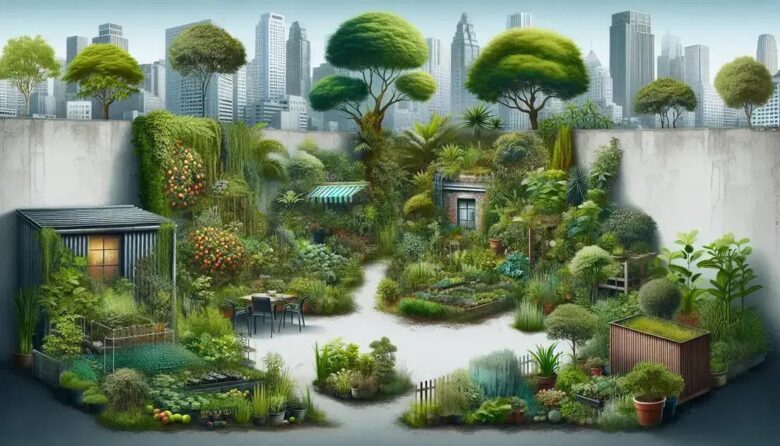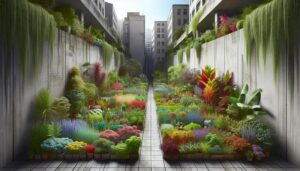Urban permaculture involves creating sustainable, eco-friendly gardens in city spaces by using compact or dwarf plants, vertical gardening, and companion planting, overcoming challenges like limited space and poor soil, and maintaining them through regular watering, organic fertilization, and pest management.
Permaculture is not just a buzzword; it’s a way to transform a tiny urban yard into a thriving food forest. Ever thought of picking fresh produce right from your back door? It’s easier than you think. Let’s dive into the methods and choices that turn a small city space into a flourishing ecosystem.
What is permaculture and why it matters
Permaculture is a holistic approach to agriculture and sustainable living that revolves around mimicking natural ecosystems. It emphasizes design principles that allow humans to live in harmony with the natural world, effectively producing food without degrading the environment. Permaculture matters because it offers a sustainable solution for food production, addressing ecological challenges such as soil degradation, water scarcity, and biodiversity loss.
Rooted in the idea that we can create a self-sustaining agricultural landscape, permaculture promotes techniques such as companion planting, water conservation, and the use of perennial plants that require minimal intervention once established. This method not only enhances soil fertility but also encourages the flourishing of local flora and fauna.
Beyond agriculture, permaculture advocates for community resilience, emphasizing self-sufficiency and ethical stewardship of natural resources. By adopting permaculture practices, individuals can contribute to creating thriving ecosystems right in their own backyards, fostering both environmental and social well-being.
Understanding Permaculture Principles
Principles such as observing and interacting, catching and storing energy, and integrating rather than segregating are central to permaculture and make it a versatile and adaptable practice suitable for varied environments.
Designing a tiny yard food forest
Designing a tiny yard food forest involves strategic planning and creativity to maximize space and yield. Start by evaluating your yard’s existing conditions, such as sunlight exposure, soil quality, and available space. Identify zones for planting different types of plants, ensuring taller trees don’t shade out smaller plants that need sun.
Consider using vertical space and layered planting, a principle from permaculture, to increase productivity. Plant trees, shrubs, and groundcovers in layers to mimic a natural forest. Fruit trees can form the canopy, while berry bushes and herbs fill the middle layers, and perennial vegetables cover the ground.
It’s important to incorporate elements that will support biodiversity and attract pollinators. Adding perennial flowers and native plants not only beautifies but also supports bees and butterflies. Implement water conservation methods like rain barrels or swales to ensure efficiency and sustainability.
Using Companion Planting
Incorporate companion planting to improve plant health and deter pests naturally. For example, plant marigolds near vegetables to repel nematodes, or pair tomatoes with basil for mutual growth enhancement.
Design pathways to allow easy access to all parts of the garden, ensuring they are wide enough for maintenance without compacting the soil unnecessarily. With thought and care, even the smallest urban yard can become a lush, productive food forest.
Choosing the right plants for urban settings
Selecting the right plants for urban settings is crucial to creating a thriving food forest in a limited space. Urban environments often present challenges such as limited sunlight, compacted soil, and less space. Thus, it’s important to choose hardy and adaptable plant species that can thrive under these conditions.
Consider using dwarf fruit trees as they offer abundant yields without requiring much space. Varieties like dwarf apple, peach, and plum trees are ideal for small yards and can be grown in pots or small plots. Companion plants like herbs and leafy greens are great choices as they mature quickly and can be harvested throughout the growing season.
Native plants are another excellent choice as they are adapted to the local climate and soil conditions, making them easier to care for. They also provide essential habitat and food sources for pollinators and beneficial insects.
Sunlight and Shade Considerations
Take note of the sun and shade patterns in your yard. Select sun-loving plants for areas that receive at least 6 hours of sunlight daily, such as tomatoes and peppers. For shaded areas, opt for shade-tolerant plants like spinach, kale, or hostas.
By strategically choosing plants suited to their specific environment and utilizing vertical gardening techniques, you can maximize both the aesthetic and functional benefits of your urban food forest.
Maintaining your urban food forest
Maintaining your urban food forest requires regular care and observation to ensure healthy growth and productivity. Start by establishing a consistent watering routine, especially during dry spells. Utilize mulch to retain moisture in the soil, suppress weeds, and maintain soil temperature.
Implement organic fertilization techniques such as composting to naturally enrich soil nutrients. Compost adds valuable organic matter that improves soil structure and fertility. Regularly check plants for signs of nutrient deficiencies or pest infestations and address them using natural solutions.
Practice pruning to promote plant health and increase airflow. This also helps manage plant size and shape, which is important in small urban spaces. Remove dead or diseased branches to prevent the spread of pathogens.
Monitoring Plant Health
Conduct periodic assessments of plant health by observing leaves, stems, and flowers for abnormalities. Early interventions can prevent issues from escalating. Encourage beneficial insects like ladybugs and bees by planting flowers that attract them, which helps keep the pest population in check.
Keeping pathways clear is important for access and monitoring. A clean, clutter-free garden space not only improves usability but also reduces the risks of pest habitats forming unnoticed. Regularly maintaining your food forest ensures it remains a dynamic and fruitful space.
Dealing with common urban gardening challenges
Urban gardening offers many benefits, but it also comes with its own set of challenges. One common issue is limited space. To overcome this, use vertical gardening techniques such as trellises and wall planters to make the most of every inch. In small spaces, hanging baskets and container gardens can also be very effective.
Poor soil quality is another challenge gardeners face in urban areas. Address this by adding organic matter like compost to enrich the soil, improving its nutrient content and water retention. Soil testing kits can help identify any deficiencies, allowing you to tailor your soil amendments accordingly.
Water management is crucial in urban gardens where rainfall might be limited. Installing a rain barrel can help collect and store rainwater for dry periods. Drip irrigation systems are efficient for providing consistent watering without overusing this precious resource.
Overcoming Pollution and Pests
Urban environments can expose plants to higher levels of pollution. Plants like ferns and bamboo are natural air purifiers and can be included in your garden design to improve air quality. Pest management in urban settings can rely on natural methods such as introducing beneficial insects like ladybugs, or using neem oil for eco-friendly pest control.
Compacting is common in urban soils. Regular aeration can help improve soil structure and root penetration. By understanding these challenges and employing smart solutions, urban gardeners can create thriving green spaces in the heart of the city.
Success stories of urban permaculture gardens
Urban permaculture gardens have transformed many concrete jungles into lush, productive spaces, offering inspiration and practical examples for aspiring gardeners. In cities around the world, individuals and communities are experiencing the benefits of these sustainable practices.
A notable success story is found in New York City, where a small community garden was transformed into a thriving permaculture paradise. By employing techniques such as companion planting and rainwater harvesting, the garden now supports a variety of fruits, vegetables, and herbs, providing food for local residents while enhancing community cohesion.
Community Engagement and Education
In Los Angeles, a rooftop permaculture garden has become a beacon of sustainability. This space not only supplies fresh produce but also serves as an educational hub for urban agriculture. Workshops and tours educate residents on sustainable practices, fostering a city-wide interest in green living.
Similarly, in Melbourne, an abandoned lot was revitalized into a permaculture garden that encourages biodiversity. Native plants support local wildlife, while the garden’s innovative use of vertical space maximizes productivity. This project has reconnected the urban inhabitants with nature and provided a green oasis in a bustling urban area.
These success stories demonstrate the power of permaculture to reshape urban landscapes, enhance food security, and build stronger communities.
Embracing Urban Permaculture
Creating a permaculture garden in an urban setting may seem challenging, but the benefits are substantial. These sustainable spaces provide fresh produce, enhance biodiversity, and strengthen community bonds. By choosing the right plants, designing efficiently, and overcoming urban challenges, anyone can transform their yard into a productive ecosystem.
Success stories from around the world show that small urban areas can become lush food forests that inspire and educate. Whether it’s saving water with rain barrels or utilizing vertical space to grow more, these gardens prove that permaculture is effective even in the heart of a city.
So, consider starting your own urban food forest today. With careful planning and sustainable practices, small urban spaces can have a big impact on the environment and community well-being.
FAQ – Frequently Asked Questions About Urban Permaculture Gardens
What is permaculture and how does it benefit urban environments?
Permaculture is a sustainable approach to agriculture that mimics natural ecosystems. In urban areas, it creates green spaces that improve biodiversity, provide fresh produce, and enhance community well-being.
How can I start a permaculture garden in my small yard?
Begin by assessing your space and conditions, such as sunlight and soil. Choose compact or dwarf plants, use vertical gardening, and implement permaculture principles like companion planting.
What are some common challenges in urban gardening, and how can I overcome them?
Common challenges include limited space, poor soil, and water management. Overcome these with vertical gardening, adding compost for soil quality, and using rain barrels for water efficiency.
Which plants are best suited for an urban permaculture garden?
Choose plants that are hardy and adaptable, such as dwarf fruit trees, herbs, and native plants. These thrive in urban conditions and support local wildlife.
How can I maintain my urban food forest effectively?
Establish a routine with regular watering, organic fertilization, pruning, and pest monitoring. Use mulch to retain moisture and support soil health.
Can you share a success story of an urban permaculture garden?
In New York City, a community transformed a small garden using permaculture techniques, providing food and improving community ties. This demonstrates the impact even small spaces can have when designed sustainably.



